Hoffman D.M., Singh B., Thomas J.H. (Eds). Handbook of Vacuum Science and Technology
Подождите немного. Документ загружается.

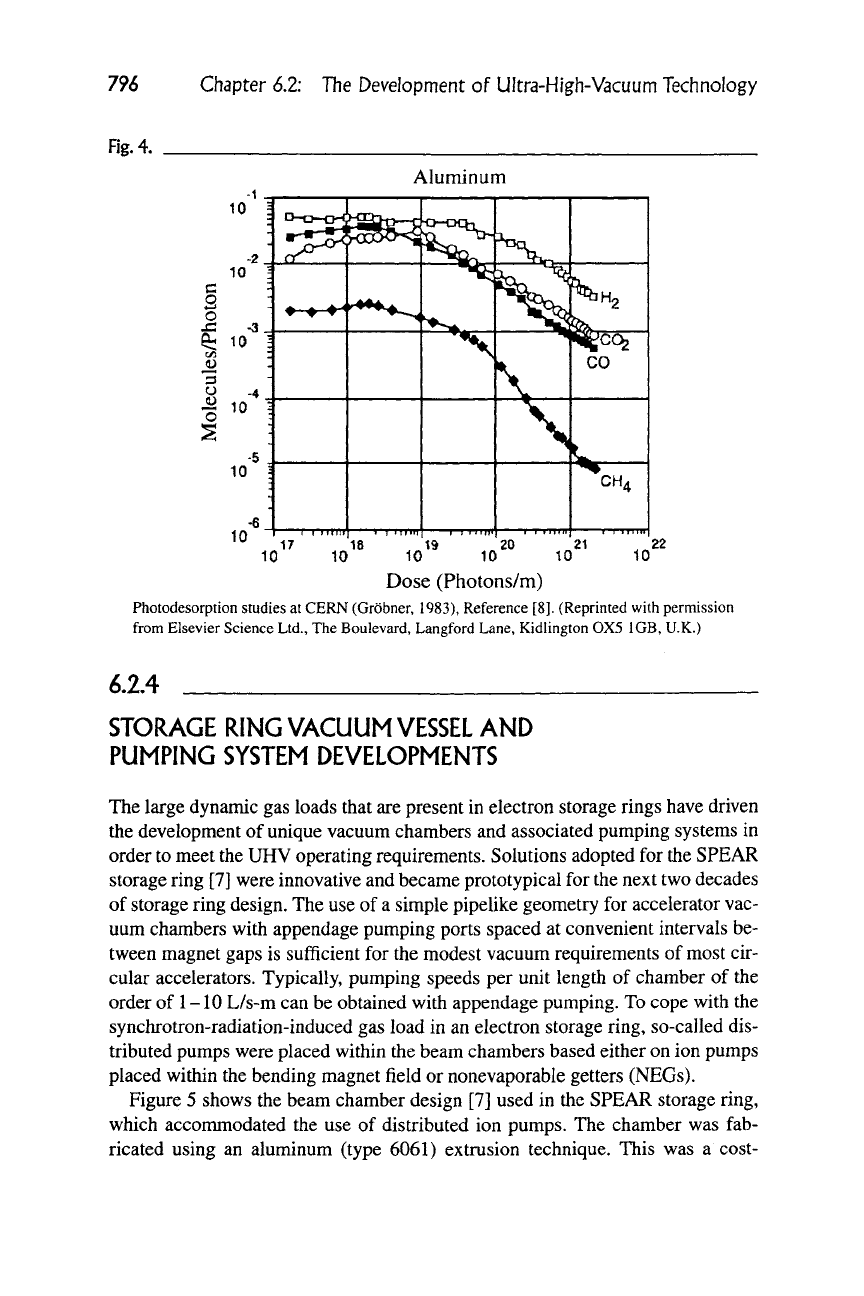
796
Chapter 6.2: The Development of Ultra-High-Vacuum Technology
Rg.4.
10
c
o 4-i
o
x:
fc^
C/5
(L)
3
O
<D
-3
10
-4
10
10
-6
10
Aluminum
i
o—a--.QH
3
B
J
1 1
1
miir 1 1 Mini'
£^
"^N
1 1
iJiii'^
X.
ioJN
\
\
r 1 nir7i
VH2
CO
c
CH4
1 t 1 tun
10
17
18
1»
20 21
10
22
10 10 10 to
Dose (Photons/m)
Photodesorption studies at CERN (Grobner, 1983), Reference [8]. (Reprinted with permission
from Elsevier Science Ltd., The Boulevard, Langford Lane, Kidlington 0X5 IGB, U.K.)
6.2.4
STORAGE RING VACUUM
VESSEL
AND
PUMPING SYSTEM DEVELOPMENTS
The large dynamic gas loads that are present in electron storage rings have driven
the development of unique vacuum chambers and associated pumping systems in
order to meet the UHV operating requirements. Solutions adopted for the SPEAR
storage ring [7] were innovative and became prototypical for the next two decades
of storage ring design. The use of a simple pipelike geometry for accelerator vac-
uum chambers with appendage pumping ports spaced at convenient intervals be-
tween magnet gaps is sufficient for the modest vacuum requirements of most cir-
cular accelerators. Typically, pumping speeds per unit length of chamber of the
order of 1-10 L/s-m can be obtained with appendage pumping. To cope with the
synchrotron-radiation-induced gas load in an electron storage ring, so-called dis-
tributed pumps were placed within the beam chambers based either on ion pumps
placed within the bending magnet field or nonevaporable getters (NEGs).
Figure 5 shows the beam chamber design [7] used in the SPEAR storage ring,
which accommodated the use of distributed ion pumps. The chamber was fab-
ricated using an aluminum (type 6061) extrusion technique. This was a cost-

6.2.4 Storage
Ring
Vacuum Vessel
and
Pumping System Developments
797
Fig.
5.
Aluminum
extrusion
Heater
Water cooling
channels
Distributed
ion pump
SPEAR vacuum vessel design (1971), Reference [7].
effective solution for producing a long (200 m), multichambered, nonconcentric
vessel. A cooling channel and ridged surface were extruded in the outer face of
the chamber to deal with the localized heat load from incident synchrotron radia-
tion. Many storage rings built after SPEAR, particularly those specifically de-
signed as synchrotron light sources, have taken advantage of extruded aluminum
chambers, because of the ease of fabrication and the ability to deal with the syn-
chrotron radiation heat loads with coextruded cooling channels (and the intrinsic
high thermal conductivity of aluminum). Extruded chamber designs made after
SPEAR often included a multichamber arrangement that allowed the beam cham-
ber to be isolated from a chamber that contained the distributed pumping ele-
ments, in order to minimize beam impedance effects.
The use of aluminum for storage ring vacuum chambers has generated a wealth
of related development for the use of aluminum alloys in vacuum, such as effective
surface-cleaning methods [18], aluminum-stainless steel bonding methods [24],
vacuum-certified aluminum welding, and aluminum vacuum components [25].
As the synchrotron radiation power was increased for storage rings designed as
dedicated light sources, specific synchrotron-radiation-absorbing structures had
to be designed for the dipole magnet chambers to handle the localized heat loads.
These structures have been as simple as copper bars brazed to the radiation plane
of stainless steel chambers and as sophisticated as water-cooled absorbers with
Cu, C, or Be as the radiation-absorbing material. [26]
The development of two classes of distributed pumps for storage rings has had
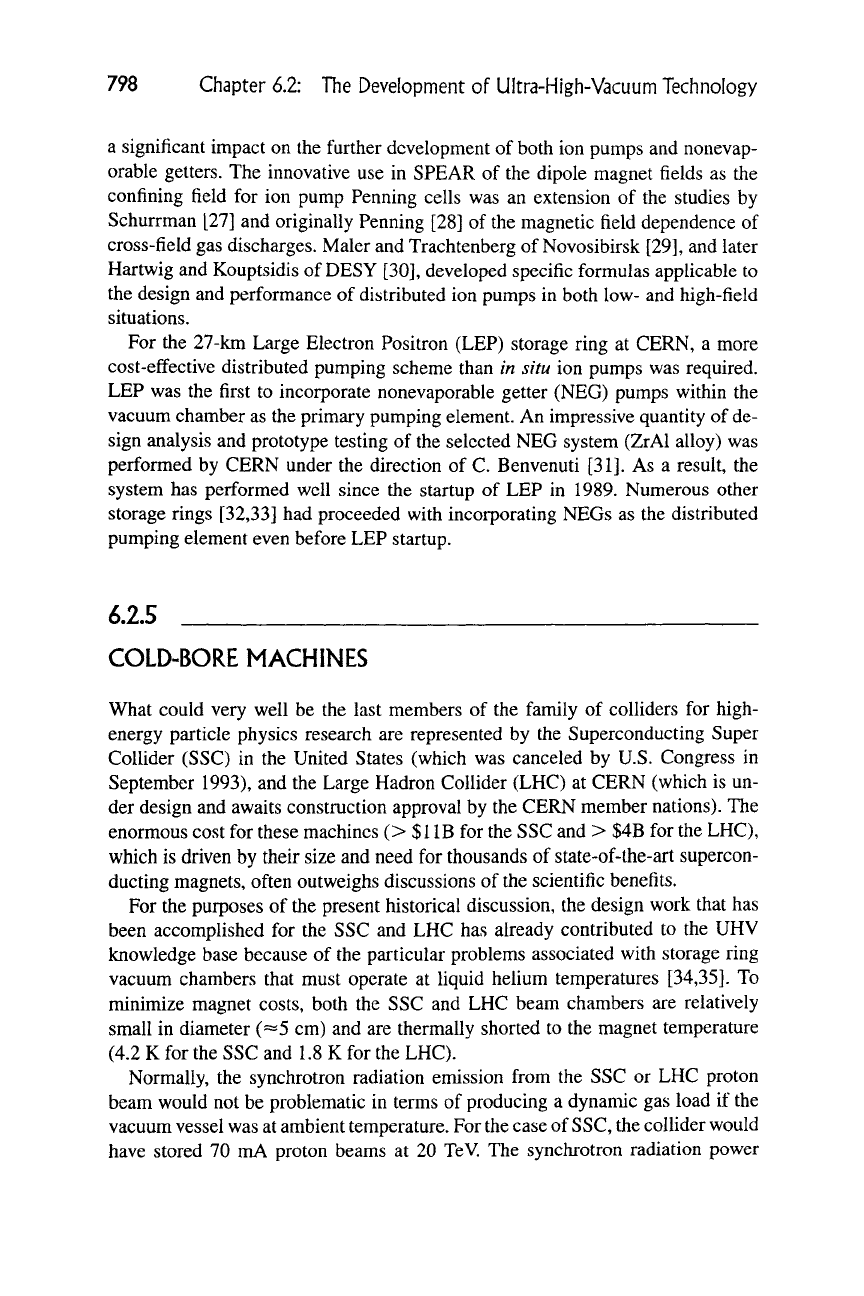
798 Chapter 6.2: The Development of Ultra-High-Vacuum Technology
a significant impact on the further development of both ion pumps and nonevap-
orable getters. The innovative use in SPEAR of the dipole magnet fields as the
confining field for ion pump Penning cells was an extension of the studies by
Schurrman [27] and originally Penning [28] of the magnetic field dependence of
cross-field gas discharges. Maler and Trachtenberg of Novosibirsk [29], and later
Hartwig and Kouptsidis of DESY [30], developed specific formulas applicable to
the design and performance of distributed ion pumps in both low- and high-field
situations.
For the 27-km Large Electron Positron (LEP) storage ring at CERN, a more
cost-effective distributed pumping scheme than in situ ion pumps was required.
LEP was the first to incorporate nonevaporable getter (NEG) pumps within the
vacuum chamber as the primary pumping element. An impressive quantity of de-
sign analysis and prototype testing of the selected NEG system (ZrAl alloy) was
performed by CERN under the direction of C. Benvenuti [31]. As a result, the
system has performed well since the startup of LEP in 1989. Numerous other
storage rings [32,33] had proceeded with incorporating NEGs as the distributed
pumping element even before LEP startup.
6.2.5
COLD-BORE MACHINES
What could very well be the last members of the family of colliders for high-
energy particle physics research are represented by the Superconducting Super
Collider (SSC) in the United States (which was canceled by U.S. Congress in
September 1993), and the Large Hadron Collider (LHC) at CERN (which is un-
der design and awaits construction approval by the CERN member nations). The
enormous cost for these machines (>
$1
IB for the SSC and > $4B for the LHC),
which is driven by their size and need for thousands of state-of-the-art supercon-
ducting magnets, often outweighs discussions of the scientific benefits.
For the purposes of the present historical discussion, the design work that has
been accomplished for the SSC and LHC has already contributed to the UHV
knowledge base because of the particular problems associated with storage ring
vacuum chambers that must operate at liquid helium temperatures [34,35]. To
minimize magnet costs, both the SSC and LHC beam chambers are relatively
small in diameter (—5 cm) and are thermally shorted to the magnet temperature
(4.2 K for the SSC and 1.8 K for the LHC).
Normally, the synchrotron radiation emission from the SSC or LHC proton
beam would not be problematic in terms of producing a dynamic gas load if the
vacuum vessel was at ambient temperature. For the case of
SSC,
the collider would
have stored 70 mA proton beams at 20 TeV. The synchrotron radiation power

6.2.5 Cold-Bore Machines
799
onto the dipole magnet vacuum chambers is 0.14 W/m. The gas load desorbed
from such a radiation flux could be easily handled by the addition of modest dis-
tributed pumping as demonstrated in the electron rings. With ambient tempera-
ture surfaces, the photodesorbed gases will not be readsorbed on nearby surfaces
and would have a high probability of being removed from the gas phase by the
distributed pumps.
The case of photo-induced desorption and readsorption from surfaces near 4 K
is quite different. All the desorbed species of interest (CO, CO2, CH4 and H2O)
except for H2 are pumped well and have low equilibrium vapor pressures on 4 K
surfaces. Isotherm measurements on clean stainless steel at low temperatures
show that H2 is pumped and the H2 vapor pressure remains low (<10"^^ torr)
only if the H2 surface coverage remains below a monolayer [36,37]. Dynamic
pressures for the operation of both the SSC and LHC must remain below the
10 ~ ^^
torr range in order to prevent excessive beam scattering and excessive heat
load on the magnet cryostat as a result of the beam scattering. A proposed design
feature (Figure 6) within the cold-bore vacuum chambers to prevent the dynamic
pressure from exceeding the
10
" '^ torr limit is the incorporation of an intermedi-
ate temperature liner (@ —20 K) between the beam aperture and cold vessel wall.
This liner would intercept the synchrotron radiation and be partially slotted or
perforated to allow desorbed H2 molecules into the interspace. The 1.9 K operat-
ing temperature of the LHC cold bore is sufficiently low to pump H2 above mono-
layer quantities without exceeding the dynamic vacuum limits. However, for the
Fig.
6.
52 mm OD stainless
steel tube at 1.9 K
Cu-plated
stainless
Maximum induced
quench currents
He cooling ^^ ^
5-10
K
screen
LHC vacuum vessel design (1993), Reference
[35].
(©
1993
IEEE)

800 Chapter 6.2: The Development of Ultra-High-Vacuum Technology
SSC,
some type of cryosorbing material would have to be engineered to pump
multilayer quantities of H2. The most likely candidate appears to be charcoal,
based on previous studies of the pumping characteristics of this material for the
fusion program [38] and recent work instigated by the SSC.
With the demise of the SSC, these studies will most likely proceed entirely fo-
cused on the application to LUC. The primary issues to be resolved are an under-
standing of photo-induced desorption phenomena at low temperatures (1.8-20 K)
on candidate vessel materials, and the design of a cost-effective cold-bore liner.
Information gained on the first topic adds to our basic understanding of this im-
portant process and has application to other important scientific and technical
problems such as the formation of molecules on interstellar dust grain surfaces
[39],
and the dynamic pressure response of the superconducting synchrotron light
sources used for X-ray lithography [40].
6.2.6
SUPERCONDUCTING
RF
ACCELERATORS
In addition to the use of superconducting magnets for saving power in accelerator
operations, the other significant use of superconductivity in accelerator technol-
ogy is RF acceleration cavities [41]. Linear accelerators consist primarily of an
array of RF cavities, separated by occasional magnetic elements for correcting
beam optics. In synchrotrons, the energy that the circulating beam loses due to
synchrotron radiation and other processes is restored by RF cavities interspersed
among the guiding magnets. For both applications, superconducting RF cavities
save operating costs, offer lower impedance to the accelerating beam, and can be
operated CW (continuous wave) at high gradients. The disadvantages of super-
conducting RF cavities are the cost and complication of cryogenic cooling and
the smaller operating experience base. The latter concern is being alleviated. Dur-
ing 1993 the installed acceleration capacity provided by superconducting RF cav-
ities exceeded 1 GeV, largely due to the completion of the superconducting linac
at CEB
AF,
the Continuous Electron Beam Accelerator Facility of Jefferson Lab-
oratory in Newport News, Virginia [42]. Large installations of operating super-
conducting RF systems are in the storage rings at KEK [43], DESY in Hamburg,
Germany [44], and LEP [45]; the latter machine is in the process of upgrading all
its RF cavities to superconducting versions in order to double the achieved final
energy (to 100 GeV) in a cost-effective manner.
Over 20 years of development has been invested in superconducting RF
technology, resulting in the current state of the art, which is capable of fabricat-
ing production-scale cavity assemblies with accelerating gradients greater than
20 MV/m [46]. These high-performance cavities will also find use in compact
CW linacs for driving free-electron lasers, which will be useful for industrial
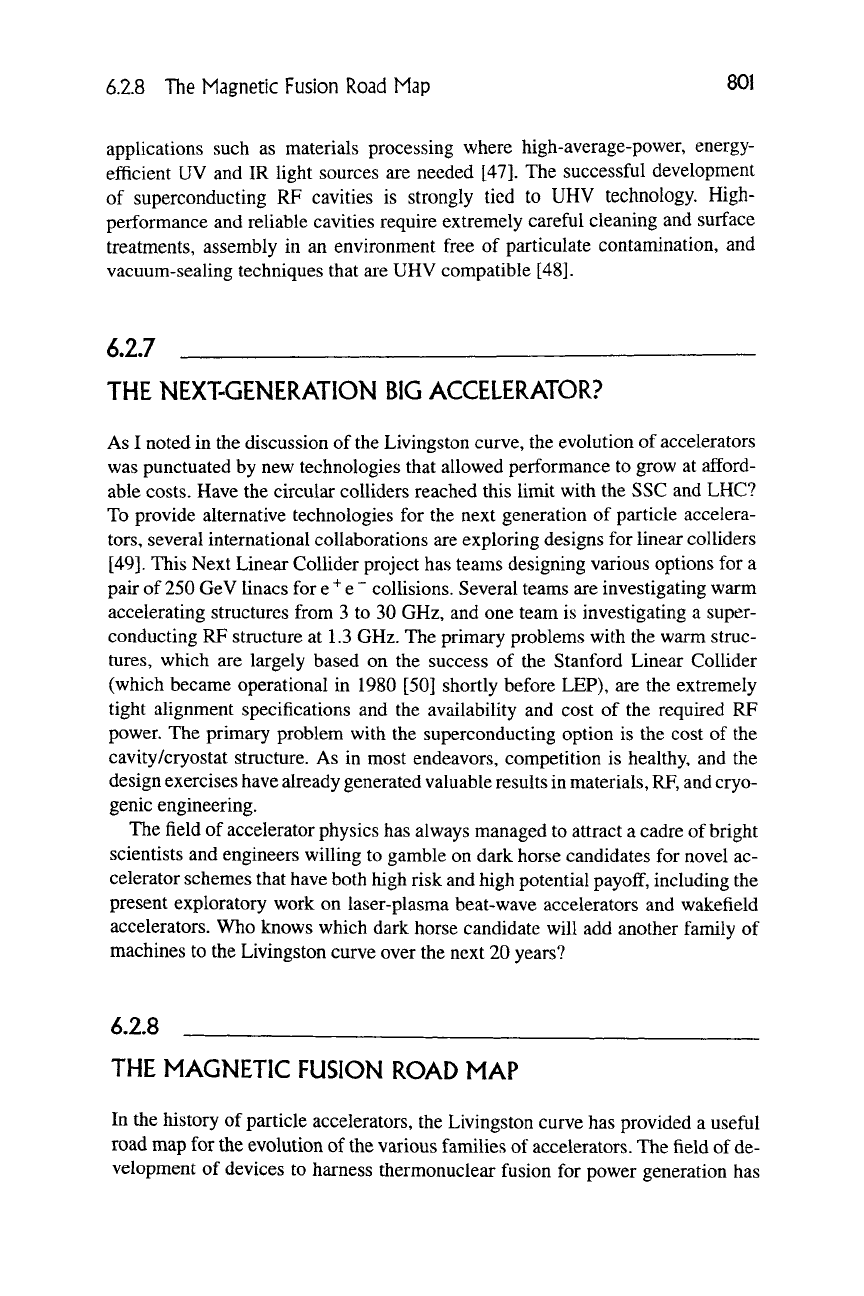
6.2.8 The Magnetic Fusion Road Map 801
applications such as materials processing where high-average-power, energy-
efficient UV and IR light sources are needed [47]. The successful development
of superconducting RF cavities is strongly tied to UHV technology. High-
performance and reliable cavities require extremely careful cleaning and surface
treatments, assembly in an environment free of particulate contamination, and
vacuum-sealing techniques that aie UHV compatible [48].
6.2.7
THE NEXT-GENERATION BIG ACCELERATOR?
As I noted in the discussion of the Livingston curve, the evolution of accelerators
was punctuated by new technologies that allowed performance to grow at afford-
able costs. Have the circular colliders reached this limit with the SSC and LHC?
To provide alternative technologies for the next generation of particle accelera-
tors,
several international collaborations are exploring designs for linear colliders
[49].
This Next Linear Collider project has teams designing various options for a
pair of 250 GeV linacs for e
"*'
e
~
collisions. Several teams are investigating warm
accelerating structures from 3 to 30 GHz, and one team is investigating a super-
conducting RF structure at 1.3 GHz. The primary problems with the warm struc-
tures,
which are largely based on the success of the Stanford Linear Collider
(which became operational in 1980 [50] shortly before LEP), are the extremely
tight alignment specifications and the availability and cost of the required RF
power. The primary problem with the superconducting option is the cost of the
cavity/cryostat structure. As in most endeavors, competition is healthy, and the
design exercises have akeady generated valuable results in materials,
RF,
and cryo-
genic engineering.
The field of accelerator physics has always managed to attract a cadre of bright
scientists and engineers willing to gamble on dark horse candidates for novel ac-
celerator schemes that have both high risk and high potential
payoff,
including the
present exploratory work on laser-plasma beat-wave accelerators and wakefield
accelerators. Who knows which dark horse candidate will add another family of
machines to the Livingston curve over the next 20 years?
6.2.8
THE MAGNETIC FUSION ROAD MAP
In the history of particle accelerators, the Livingston curve has provided a useful
road map for the evolution of the various families of accelerators. The field of de-
velopment of devices to harness thermonuclear fusion for power generation has
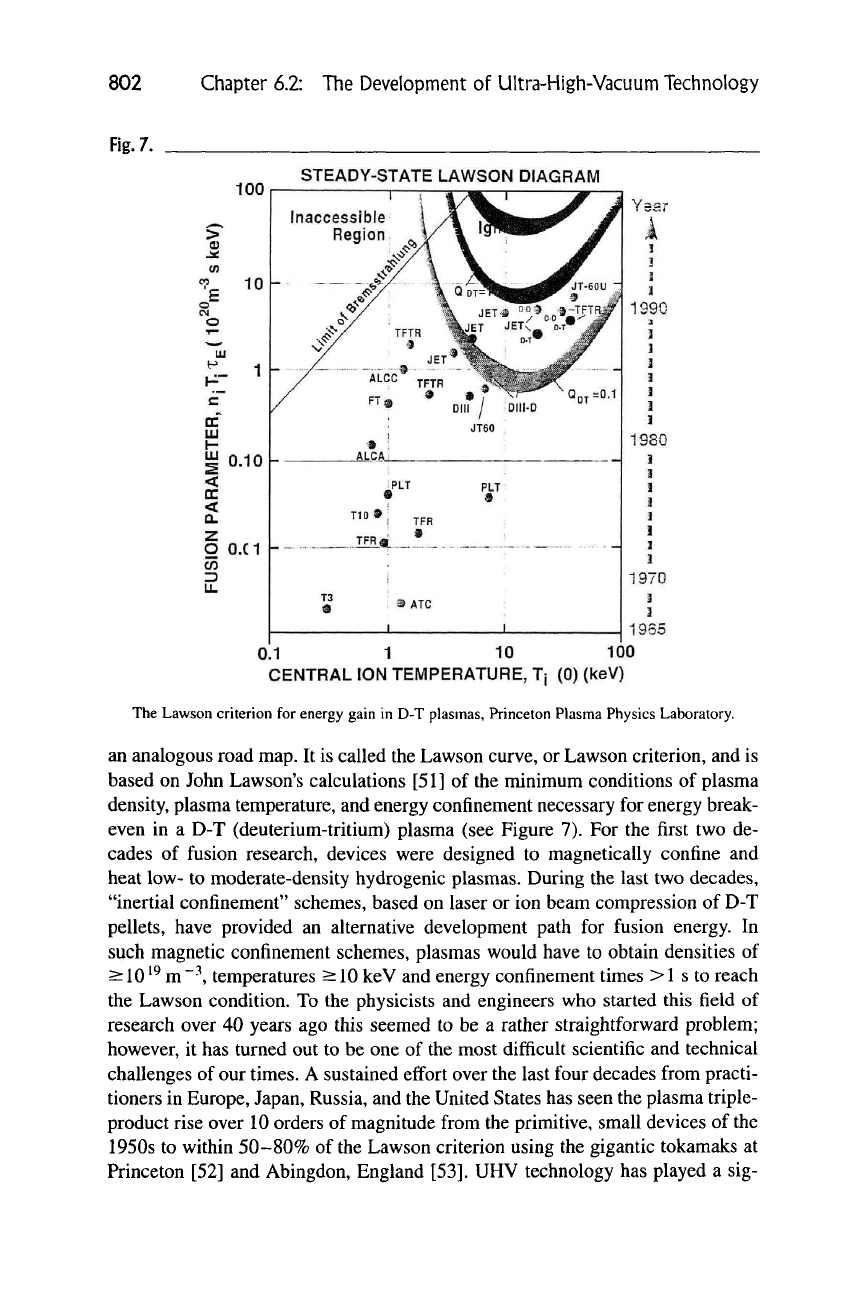
802 Chapter 6.2: The Development of Ultra-High-Vacuum Technology
Fig.
7.
>
0)
(0
m
'E
o
o
T—
UJ
h^"
c"
Q:
m
LU
s
<
cc
<
Q.
z
o
CO
3
u.
100
10
1
0.10
0.C1
STEADY-STATE LAWSON DIAGRAM
I ; 4 /^^ 1
inaccessible 1 y\ ^jj^^M
Region ^y \
'9^^^^
^JT-60U "
o^y^ \ JET* °°^.oV-!#
/ ALCC TFTR ^|MP
/ FT* • •7 ^^f^
/ "^'^ Dill / Dlll-D
JT60
#
;
ALCA_
^PLT PLT
• #
TIO • i TFR
TFR4 • „_ ;
;3 »ATC
1 1
QDT=0-1
-~ -
Year
A
1
3
]
1
199C
a
3
]
1
i
]
]
1980
]
1
i
1
1
3
1
1970
1
I
1965
0.1
10
100
CENTRAL ION TEIVIPERATURE, Tj (0) (keV)
The Lawson criterion for energy gain in D-T plasmas, Princeton Plasma Physics Laboratory.
an analogous road map. It is called the Lawson curve, or Lawson criterion, and is
based on John Lawson's calculations [51] of the minimum conditions of plasma
density, plasma temperature, and energy confinement necessary for energy break-
even in a D-T (deuterium-tritium) plasma (see Figure 7). For the first two de-
cades of fusion research, devices were designed to magnetically confine and
heat low- to moderate-density hydrogenic plasmas. During the last two decades,
"inertial confinement" schemes, based on laser or ion beam compression of D-T
pellets, have provided an alternative development path for fusion energy. In
such magnetic confinement schemes, plasmas would have to obtain densities of
>10^^
m~\ temperatures >10 keV and energy confinement times >1 s to reach
the Lawson condition. To the physicists and engineers who started this field of
research over 40 years ago this seemed to be a rather straightforward problem;
however, it has turned out to be one of the most difficult scientific and technical
challenges of our times. A sustained effort over the last four decades from practi-
tioners in Europe, Japan, Russia, and the United States has seen the plasma triple-
product rise over 10 orders of magnitude from the primitive, small devices of the
1950s to within 50-80% of the Lawson criterion using the gigantic tokamaks at
Princeton [52] and Abingdon, England [53]. UHV technology has played a sig-
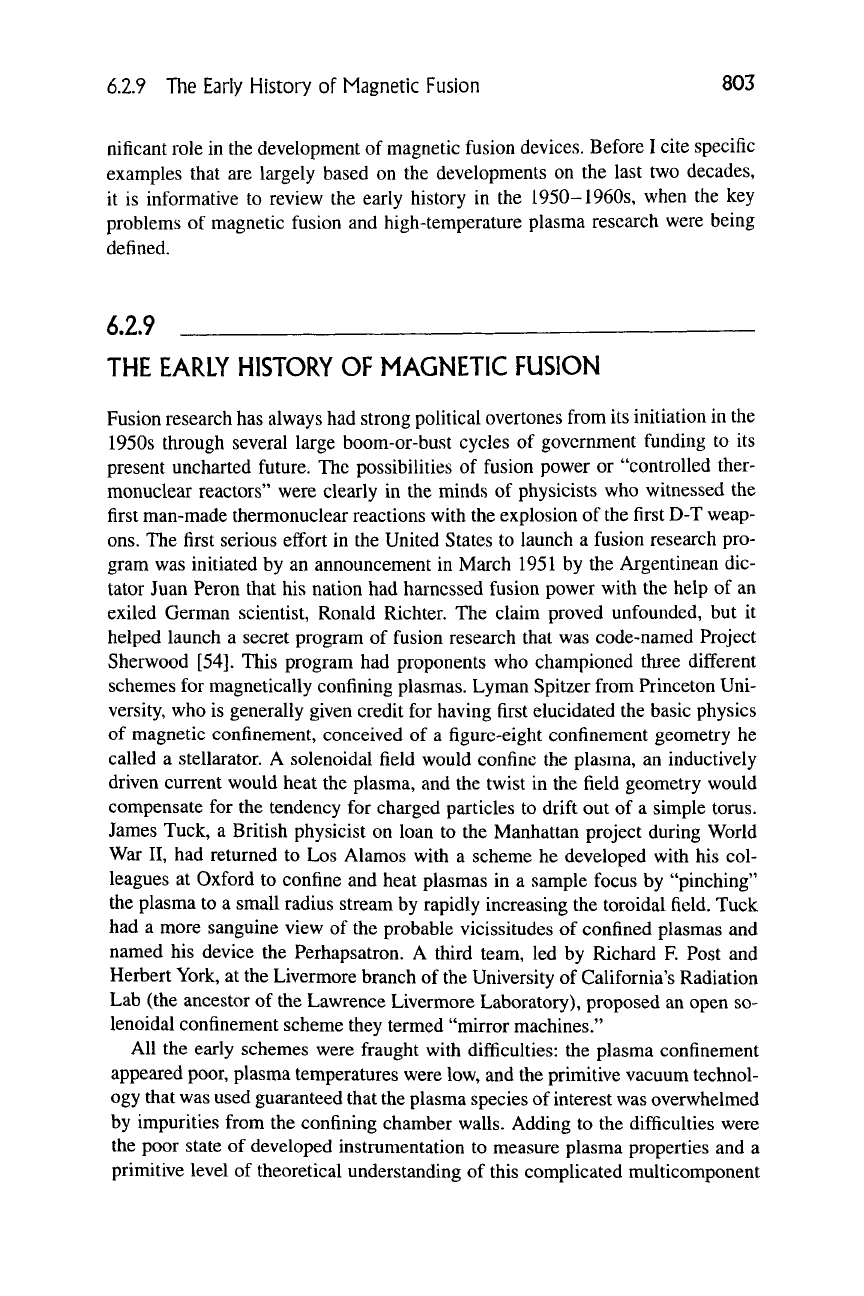
6.2.9 The Early History of Magnetic Fusion 803
nificant role in the development of magnetic fusion devices. Before I cite specific
examples that are largely based on the developments on the last two decades,
it is informative to review the early history in the 1950-1960s, when the key
problems of magnetic fusion and high-temperature plasma research were being
defined.
6.2.9
THE EARLY HISTORY OF MAGNETIC FUSION
Fusion research has always had strong political overtones from its initiation in the
1950s through several large boom-or-bust cycles of government funding to its
present uncharted future. The possibilities of fusion power or "controlled ther-
monuclear reactors" were clearly in the minds of physicists who witnessed the
first man-made thermonuclear reactions with the explosion of the first D-T weap-
ons.
The first serious effort in the United States to launch a fusion research pro-
gram was initiated by an announcement in March 1951 by the Argentinean dic-
tator Juan Peron that his nation had haincssed fusion power with the help of an
exiled German scientist, Ronald Richter. The claim proved unfounded, but it
helped launch a secret program of fusion research that was code-named Project
Sherwood [54]. This program had proponents who championed three different
schemes for magnetically confining plasmas. Lyman Spitzer from Princeton Uni-
versity, who is generally given credit for having first elucidated the basic physics
of magnetic confinement, conceived of a figure-eight confinement geometry he
called a stellarator. A solenoidal field would confine the plasma, an inductively
driven current would heat the plasma, and the twist in the field geometry would
compensate for the tendency for charged particles to drift out of a simple torus.
James Tuck, a British physicist on loan to the Manhattan project during World
War II, had returned to Los Alamos with a scheme he developed with his col-
leagues at Oxford to confine and heat plasmas in a sample focus by "pinching"
the plasma to a small radius stream by rapidly increasing the toroidal field. Tuck
had a more sanguine view of the probable vicissitudes of confined plasmas and
named his device the Perhapsatron. A third team, led by Richard F. Post and
Herbert York, at the Livermore branch of the University of California's Radiation
Lab (the ancestor of the Lawrence Livermore Laboratory), proposed an open so-
lenoidal confinement scheme they termed "mirror machines."
All the early schemes were fraught with difficulties: the plasma confinement
appeared poor, plasma temperatures were low, and the primitive vacuum technol-
ogy that was used guaranteed that the plasma species of interest was overwhelmed
by impurities from the confining chamber walls. Adding to the difficulties were
the poor state of developed instrumentation to measure plasma properties and a
primitive level of theoretical understanding of this complicated multicomponent
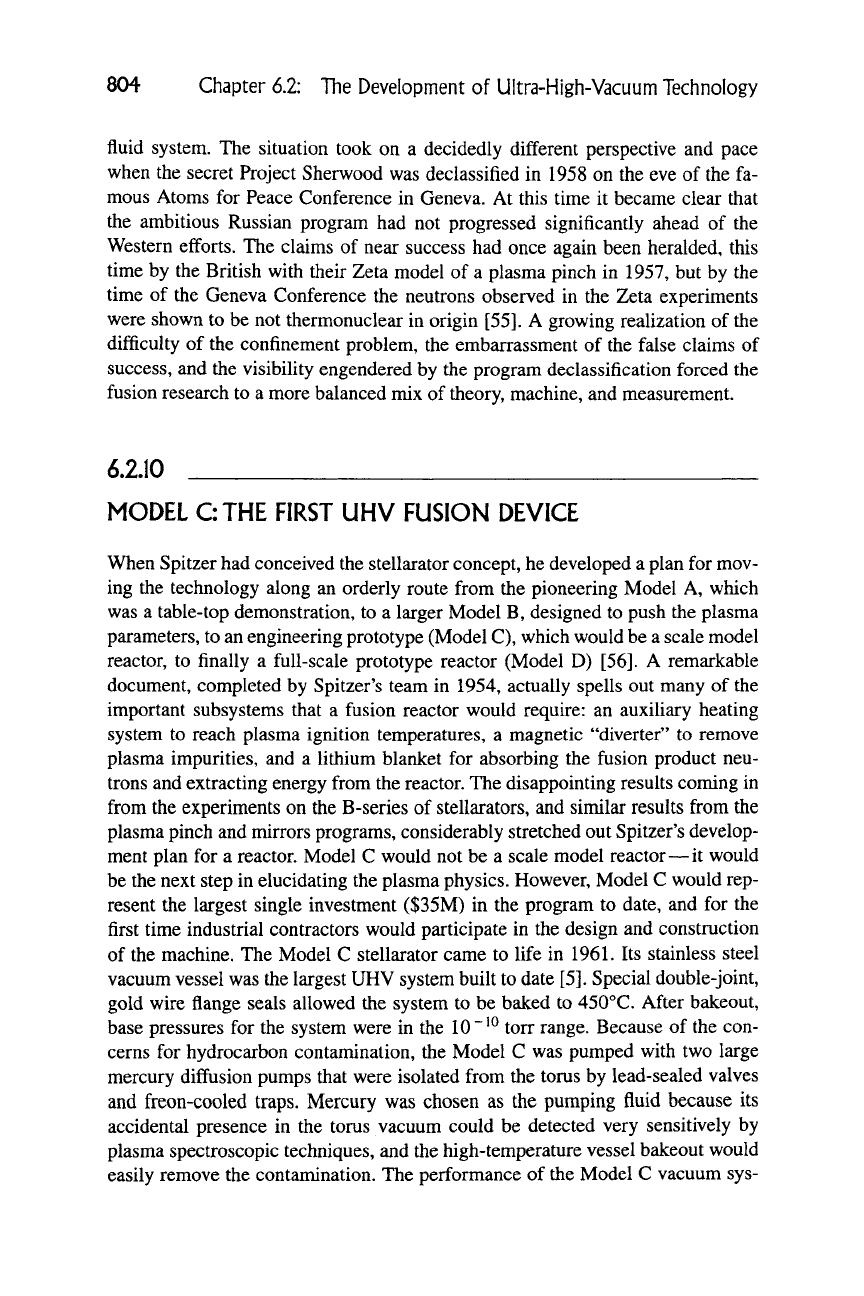
804 Chapter 6.2: The Development of Ultra-High-Vacuum Technology
fluid system. The situation took on a decidedly different perspective and pace
vv^hen the secret Project Sherwood was declassified in 1958 on the eve of the fa-
mous Atoms for Peace Conference in Geneva. At this time it became clear that
the ambitious Russian program had not progressed significantly ahead of the
Western efforts. The claims of near success had once again been heralded, this
time by the British with their Zeta model of a plasma pinch in 1957, but by the
time of the Geneva Conference the neutrons observed in the Zeta experiments
were shown to be not thermonuclear in origin [55]. A growing realization of the
difficulty of the confinement problem, the embarrassment of the false claims of
success, and the visibility engendered by the program declassification forced the
fusion research to a more balanced mix of theory, machine, and measurement.
6.2.10
MODEL CTHE FIRST UHV FUSION DEVICE
When Spitzer had conceived the stellarator concept, he developed a plan for mov-
ing the technology along an orderly route from the pioneering Model A, which
was a table-top demonstration, to a larger Model B, designed to push the plasma
parameters, to an engineering prototype (Model C), which would be a scale model
reactor, to finally a full-scale prototype reactor (Model D) [56]. A remarkable
document, completed by Spitzer's team in 1954, actually spells out many of the
important subsystems that a fusion reactor would require: an auxiliary heating
system to reach plasma ignition temperatures, a magnetic "diverter" to remove
plasma impurities, and a lithium blanket for absorbing the fusion product neu-
trons and extracting energy from the reactor. The disappointing results coming in
from the experiments on the B-series of stellarators, and similar results from the
plasma pinch and mirrors programs, considerably stretched out Spitzer's develop-
ment plan for a reactor. Model C would not be a scale model reactor—it would
be the next step in elucidating the plasma physics. However, Model C would rep-
resent the largest single investment ($35M) in the program to date, and for the
first time industrial contractors would participate in the design and construction
of the machine. The Model C stellarator came to life in 1961. Its stainless steel
vacuum vessel was the largest UHV system built to date [5]. Special double-joint,
gold wire flange seals allowed the system to be baked to 450°C. After bakeout,
base pressures for the system were in the
10 ~^^
ton* range. Because of the con-
cerns for hydrocarbon contamination, the Model C was pumped with two large
mercury diffusion pumps that were isolated from the torus by lead-sealed valves
and freon-cooled traps. Mercury was chosen as the pumping fluid because its
accidental presence in the torus vacuum could be detected very sensitively by
plasma spectroscopic techniques, and the high-temperature vessel bakeout would
easily remove the contamination. The performance of the Model C vacuum sys-
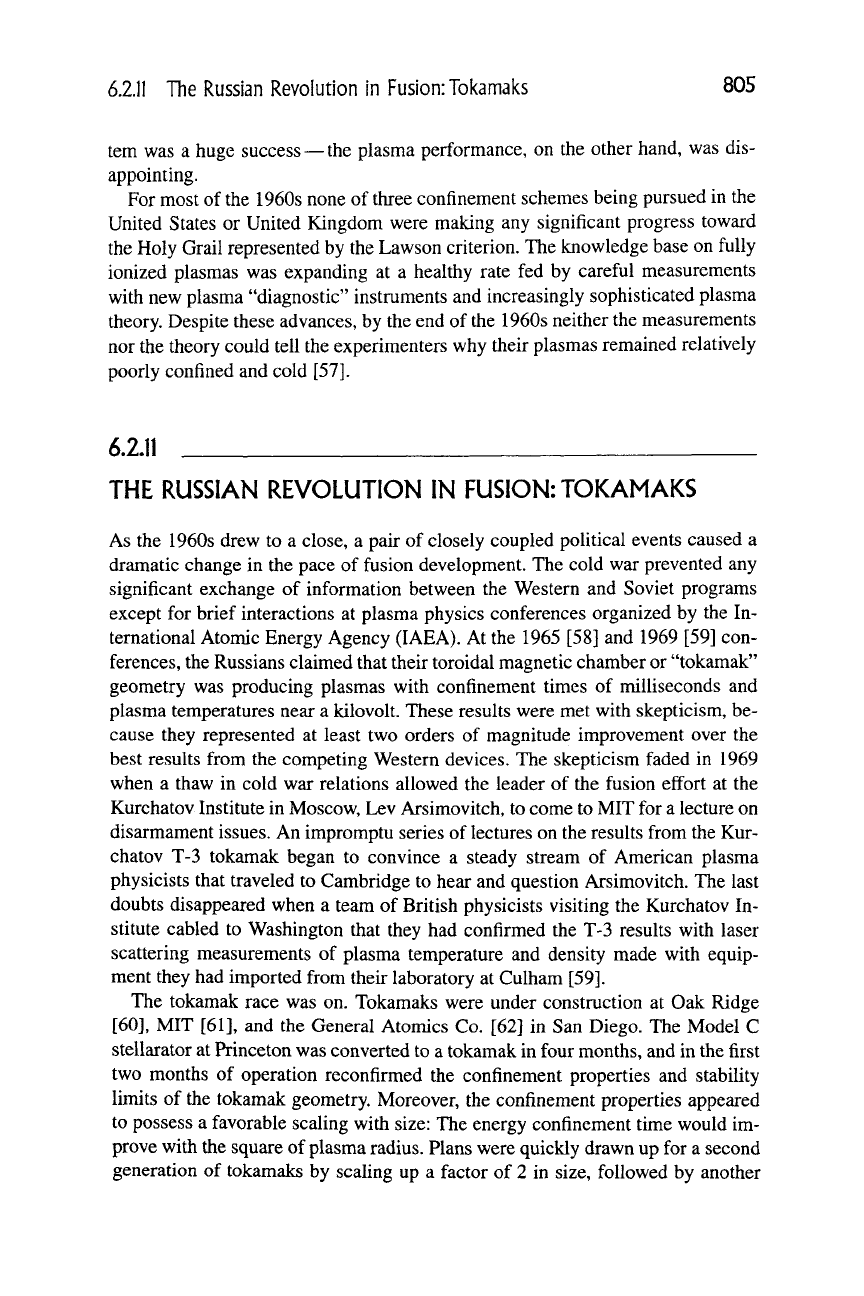
6.2.11
The
Russian Revolution
in
Fusion:
Tokamaks
805
tern was a huge success —
the
plasma performance, on the other hand, was dis-
appointing.
For most of the 1960s none of three confinement schemes being pursued in the
United States or United Kingdom were making any significant progress toward
the Holy Grail represented by the Lawson criterion. The knowledge base on fully
ionized plasmas was expanding at a healthy rate fed by careful measurements
with new plasma "diagnostic" instruments and increasingly sophisticated plasma
theory. Despite these advances, by the end of the 1960s neither the measurements
nor the theory could tell the experimenters why their plasmas remained relatively
poorly confined and cold [57].
6.2.11
THE RUSSIAN REVOLUTION IN
FUSION:
TOKAMAKS
As the 1960s drew to a close, a pair of closely coupled political events caused a
dramatic change in the pace of fusion development. The cold war prevented any
significant exchange of information between the Western and Soviet programs
except for brief interactions at plasma physics conferences organized by the In-
ternational Atomic Energy Agency (IAEA). At the 1965 [58] and 1969 [59] con-
ferences, the Russians claimed that their toroidal magnetic chamber or "tokamak"
geometry was producing plasmas with confinement times of milliseconds and
plasma temperatures near a kilovolt. These results were met with skepticism, be-
cause they represented at least two orders of magnitude improvement over the
best results from the competing Western devices. The skepticism faded in 1969
when a thaw in cold war relations allowed the leader of the fusion effort at the
Kurchatov Institute in Moscow, Lev Arsimovitch, to come to MIT for a lecture on
disarmament issues. An impromptu series of lectures on the results from the Kur-
chatov T-3 tokamak began to convince a steady stream of American plasma
physicists that traveled to Cambridge to hear and question Arsimovitch. The last
doubts disappeared when a team of British physicists visiting the Kurchatov In-
stitute cabled to Washington that they had confirmed the T-3 results with laser
scattering measurements of plasma temperature and density made with equip-
ment they had imported from their laboratory at Culham [59].
The tokamak race was on. Tokamaks were under construction at Oak Ridge
[60],
MIT [61], and the General Atomics Co. [62] in San Diego. The Model C
stellarator at Princeton was converted to a tokamak in four months, and in the first
two months of operation reconfirmed the confinement properties and stability
limits of the tokamak geometry. Moreover, the confinement properties appeared
to possess a favorable scaling with size: The energy confinement time would im-
prove with the square of plasma radius. Plans were quickly drawn up for a second
generation of tokamaks by scaling up a factor of 2 in size, followed by another
